Support Hidden Compass
Our articles are crafted by humans (not generative AI). Support Team Human with a contribution!
It’s winter in the Albanian mountains. Snow clouds swirl overhead, and a soft, white powder cloaks the landscape. Somewhere beyond the peaks, ancient Ottoman villages and tiny farmsteads lie hunkered down in the valleys, and some miles to the west, a brisk coastline of untouched Mediterranean beaches sits in hibernation. It’s 1944 and World War II is raging across Europe, with the Germans occupying Albania’s airports, seaports, and capital city.
The country’s future lies on a precipice, much like the steep cliffs the Albanian and British soldiers have been marching over for the last few days. But, for now, the constant soundtrack of hooves on snow has stopped. The air is stiff, and not just because of the cold. The leaders of the Albanian and British armies have reached a stalemate.
A British officer and his bodyguard argue with the towering leader of a group of partisan Albanians. The German threat surrounds them, and no one can agree on which way to go next.
In the war’s aftermath, an Albanian military artist named Robert Permeti pored over the historic archives of this encounter so he could paint its every detail — the stern look on the dictator’s face, the tension in the shoulders of Brigadier Davies, the British officer. For Permeti, adhering to accuracy was a point of pride. But he had stepped out of ranks.
Under the tight grip of communism, his painting expressed too much — a breach of protocol at the brink of abandon.
~~
Stretching 125 miles along the Adriatic and Ionian Seas on the edge of the Balkan Peninsula, Albania has always stood at the nexus between East and West, often torn between ideals and cultures, religions and empires. Much of its history has been defined by invasion, including more than four centuries of largely Ottoman rule, which further isolated the mountainous land. Centralized governance didn’t take hold until the 20th century.
With national power comes national pride. That’s why, as Etleva Lala explains from her bookcase-lined office, a single national identity failed to take shape on its own. A stern-faced Albanian expat in Hungary, Lala teaches the lessons of her native country’s past to the rising generation of European scholars at Eötvös Loránd University.
Prior to the 20th century, she says, the people who live in what is now known as Albania honed the art of individualism. Unlike in the West, where “laws created classes and protected the ruling class,” Lala says, her voice high-pitched but kind, “among Albanians there were no restrictions.” A lack of regulations meant no clear hierarchy.
“The only way to prove yourself was to show off,” Lala says. “That kind of pride was — and still is — the hidden element in the Albanian spirituality and culture.”
The showpiece of every home was a room adorned in lavish textiles and intricately carved wood. In these spaces, the men of the region gathered to discuss the issues of the day. “The rest of the home might be poor, but this one room was an applied art in itself,” Lala says.
Her countrymen also signaled stature — and by extension, identity — through their vibrant folk attire, rich in red and purple fabrics and interlaced with gold. They brandished swords and daggers made from coral, brass, ornate wood, and shimmering silver; the extravagance of a man’s weapon secured his place in the pecking order.
“The only way to prove yourself was to show off. That kind of pride was — and still is — the hidden element in the Albanian spirituality and culture.” —Etleva Lala
Then fascism arrived, and everything changed. On April 7, 1939, Mussolini’s forces marched in. Inside agents had disarmed the Albanian defenders in the mountains, and the Italians took the major ports and overthrew King Zog I, who fled to Greece with his family and part of the Albanian Central Bank’s gold reserves. In 1943, the Nazis invaded.
In the wake of the Axis surrender a couple of years later, Enver Hoxha took the reins as the celebrated head of state who had liberated the country from occupation. A Marxist-Leninist, he became paranoid and fervently anti-West, intent on consolidating power at any cost.
Under Hoxha, Communists understood the need to create a collective identity in Albania. Art became a powerful tool for control.
“They took art out of the households,” Lala says, “and made it public property.”
Socialist realism reigned supreme. “A vessel for socialist purpose,” as Lala describes it, this national form of art had a clear intention — to unify the country under the dictatorship.
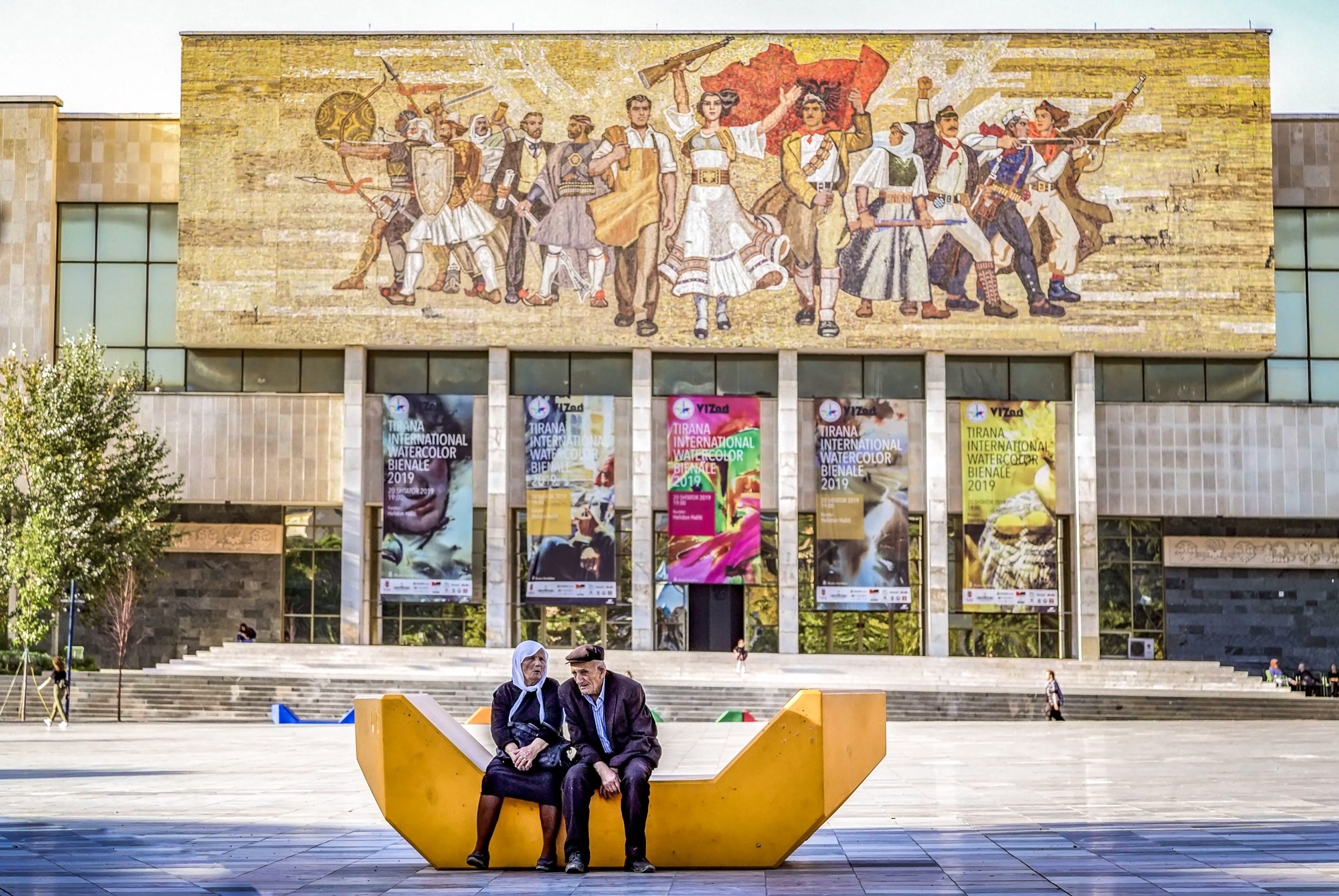
Albanians embody resilience — both in mosaic and in the flesh. Flaunting a socialist realism depiction of Albania’s triumph over centuries of invasion, the National History Museum entrance sets a dramatic backdrop to Skanderbeg Square in Tirana. Photo: Andfoto/Alamy.
Government-funded artists painted optimistic scenes of rosy-cheeked women tending to prolific fields, or children playing in the street with wide smiles. Soldiers marched in formation; partisan warriors brandished guns and triumph.
No longer did Albania teeter between ideologies. It had been pushed off the cliff.
~~
With broad shoulders and a chiseled jawline, Permeti looked every bit an archetypical military officer. Not a tall man, he stood out because of his talent as an artist.
In his studio in Librazhd, a small town at the foot of the Dinaric Alps, he often got lost in his art in the same way he had as a young boy after his father, an officer for the Albanian People’s Army, had tracked down some paint for him.
In front of his canvas, Permeti found solace. But that doesn’t mean he was alone.
This was Albania in the 1970s. A cluster of uniformed military officers stood behind Permeti, hands in their pockets, carefully watching his every brushstroke. They had not come to admire his work.
Fear filled in the cracks.
Permeti had followed in his father’s footsteps and enlisted as a teenager. After completing the military academy, he had been allowed to attend art school, where his talents had attracted attention from on high. Creating art for the regime afforded him special privileges, including time off from his official duties to retreat to this government-owned studio.
Officers often dropped by unannounced, checking to ensure his paintings conveyed the right message. Sometimes there might be one or two of them, standing silent sentinel. Other times, an intimidation of five or more officers arrived, as if they might need reinforcements. Every now and then, an officer would gruffly tell Permeti to make a change — perhaps a soldier’s face was too round, or a foot painted too small. Every minor concern required immediate revision.
Occasionally the artist would disagree, and one of the men would pick up the brush and change it himself.
Art became a powerful tool for control.
But Permeti kept cool; he knew what was at stake. His father had been put under surveillance after his loyalty to the Hoxha regime had eroded, and Permeti’s brother — a pilot — was in prison for saying the wrong thing.
~~
The blare of a siren, a scramble into position, ready to shoot at the enemy — military drills pervaded Albanian life under the dictatorship.
Domed concrete bunkers punctuated street corners and the countryside. Every young adult was required to complete basic military training, part of Hoxha’s “always ready” strategy against potential invaders. Punishment for noncompliance was severe. Tens of thousands of Albanians languished in concentration camps; thousands more had been murdered for crimes against the regime.
Decades of isolation had taken their toll, with food shortages and economic decline ravaging the country. Fear filled in the cracks.
~~
Once complete, artworks created for the Albanian government went in front of the dictator’s wife, Nexhmije Hoxha. As director of the Institute of Marxist–Leninist Studies — essentially the country’s propaganda department — she had the final say on whether a piece was satisfactory.
When it wasn’t, she was often brutal with her punishment. Men’s hands were cut off at the wrist for menial mistakes, the stories went.
When she assessed The Abyss, as Permeti called his painting of the dictator arguing with the British officer in the mountains, she was disgusted. A staunch Stalinist and Anglophobe, she demanded the work be redrawn without Brigadier Davies and his bodyguard. The scene should be all about her husband. To paint him fraternizing with the enemy — the West — was abhorrent.
Having spent so long delving into the archives to get the details right, Permeti wouldn’t have it. A tense back-and-forth with the authorities ensued, but the artist was passionate about his work and held his ground. He was willing to bet his growing reputation would protect him.
Permeti’s dangerous gamble paid off. The authorities relented, and the piece remained as he painted it. A way out of the chasm was beginning to open up before him.
~~
By the 1980s, communism was losing its grip. After four decades of tight-fisted control, Enver Hoxha fell ill and died in 1985. His handpicked successor, Ramiz Alia, attempted to revive the economy just as a pro-democracy movement was gaining momentum.
Amid this cultural shift, the idealized realm of socialist realism no longer hit the mark. “People began to understand the art wasn’t really representing what they were going through and what they were living,” says Lala, the expat professor.
In late 1990, the Communist government finally fell apart, making way for capitalism — and a tumultuous transition.
In February 1991, the world watched as thousands of pro-democracy Albanians stormed Skanderbeg Square in the capital city of Tirana, their fists raised in defiance. Demonstrators scaled a 30-foot-tall, bronze statue of Enver Hoxha and tied ropes to it, yanking until the statue lurched and, at last, crashed to the ground, stone chips flying. The moment — and the toppled monolith — marked a triumphant stand against tyranny.
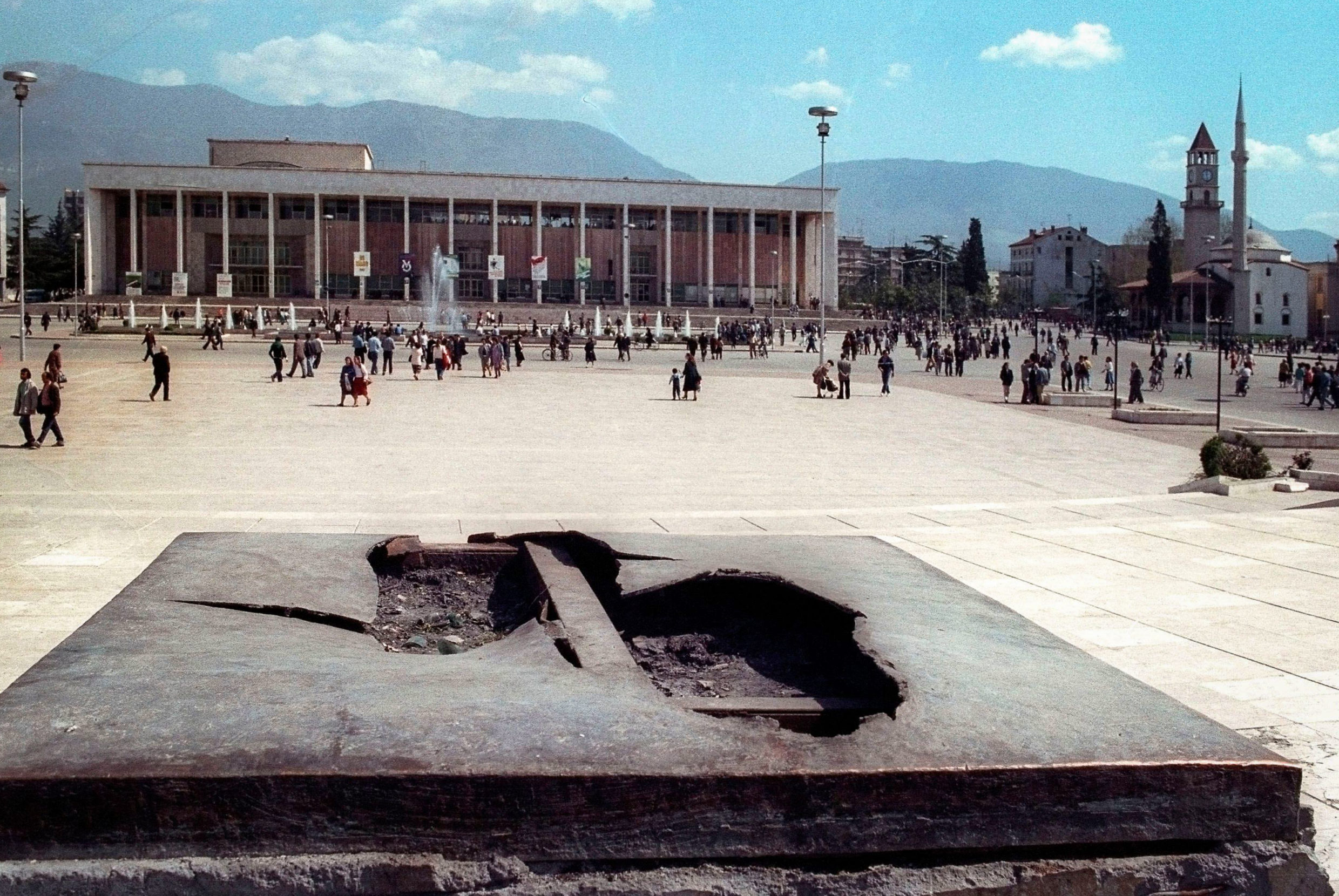
The scars of Enver Hoxha’s brutal regime lasted long past his death in 1985. But in 1991, a month after Albanian protestors pulled down a massive statue of the former dictator, all that remained was a void where bronze feet had once stood firm. Photo: Tom Szlukovenyi/Reuters/Alamy.
The unrest was just getting started, though. The country’s burgeoning financial system became ridden with Ponzi schemes. By 1997, Albanians had grown fed up with the scams, and rioters took to the streets. Angry men and women raided and looted government buildings, offices, and warehouses across the country. At least 2,000 people died as the nation careened toward civil war.
Amid the chaos, many of Permeti’s paintings were stolen.
~~
Fifteen years later, a man in a sports coat and jeans, top shirt button undone, towered confidently over a seated crowd. At nearly 6 feet 7 inches, the former basketball player stood centerstage as projected photographs flashed behind him — a swathe of towering concrete apartment blocks in Tirana painted in clashing hues of red, pink, and yellow.
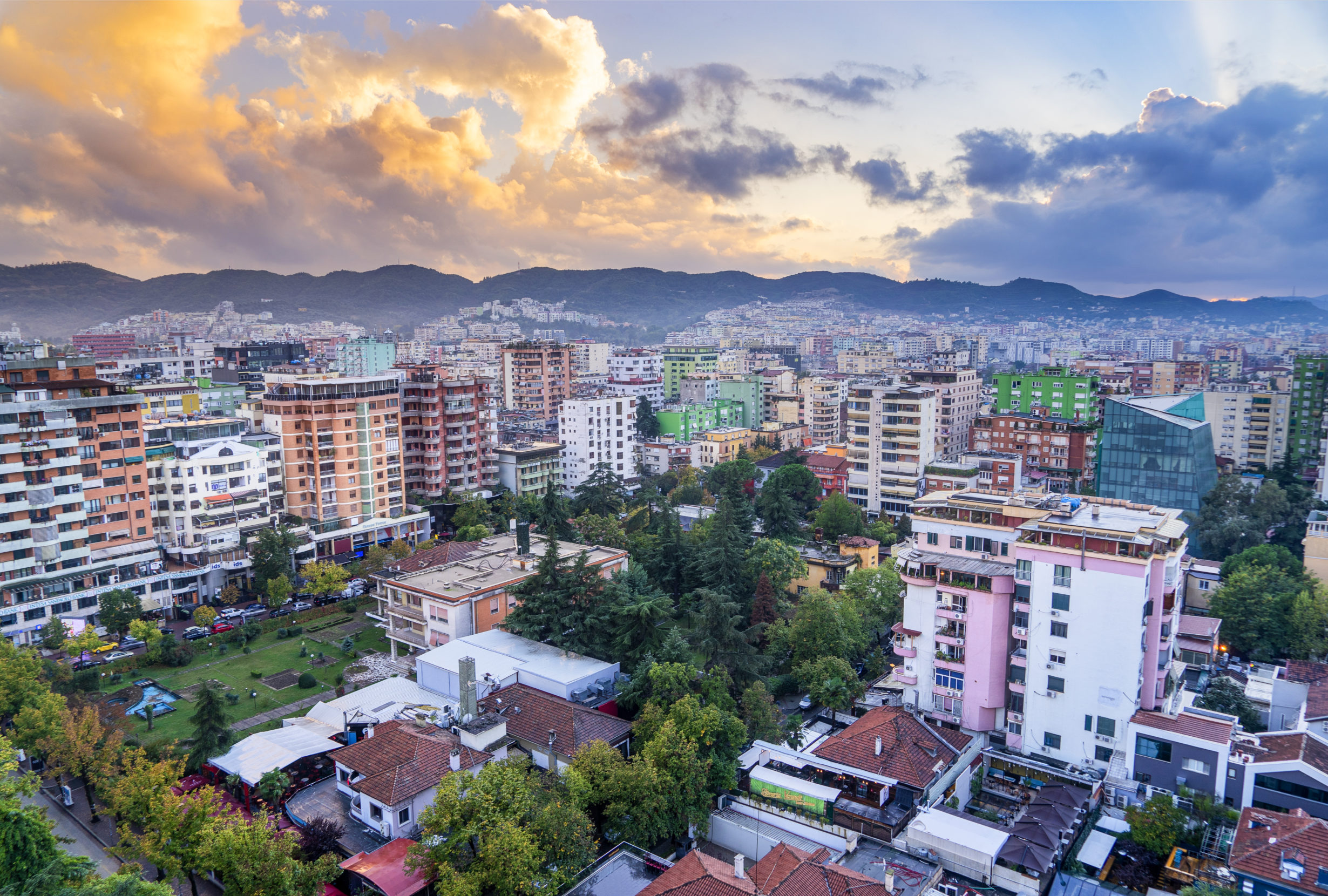
Colorful high-rises framed by the foothills of Mount Dajti make for photogenic vistas in Albania’s capital city of Tirana. Photo: Adonis Abril/Adobe.
His face lit up with an impish grin as he told how in 2000, as the new mayor of Tirana, he had caused a traffic jam with his bold color choices.
“When we painted the first building, by splashing a radiant orange on the somber gray of a facade, something unimaginable happened,” he recounted for the rapt audience gathered in Thessaloniki, Greece, for a 2012 TEDx event.
This speaker, Edi Rama, went on to tell how a crowd had formed to ogle the fresh facade “as if it were the location of some spectacular accident, or the sudden sighting of a visiting pop star.”
As an internationally renowned artist and former art professor, Rama has always understood the transformative power of art. In the 1980s, athletes were among the only Albanians allowed to leave the country, so he joined Albania’s national basketball team, dreaming of travel — and the chance to visit an art museum. Rama’s father was a prominent socialist-realist sculptor who once created an imposing marble statue of Enver Hoxha.
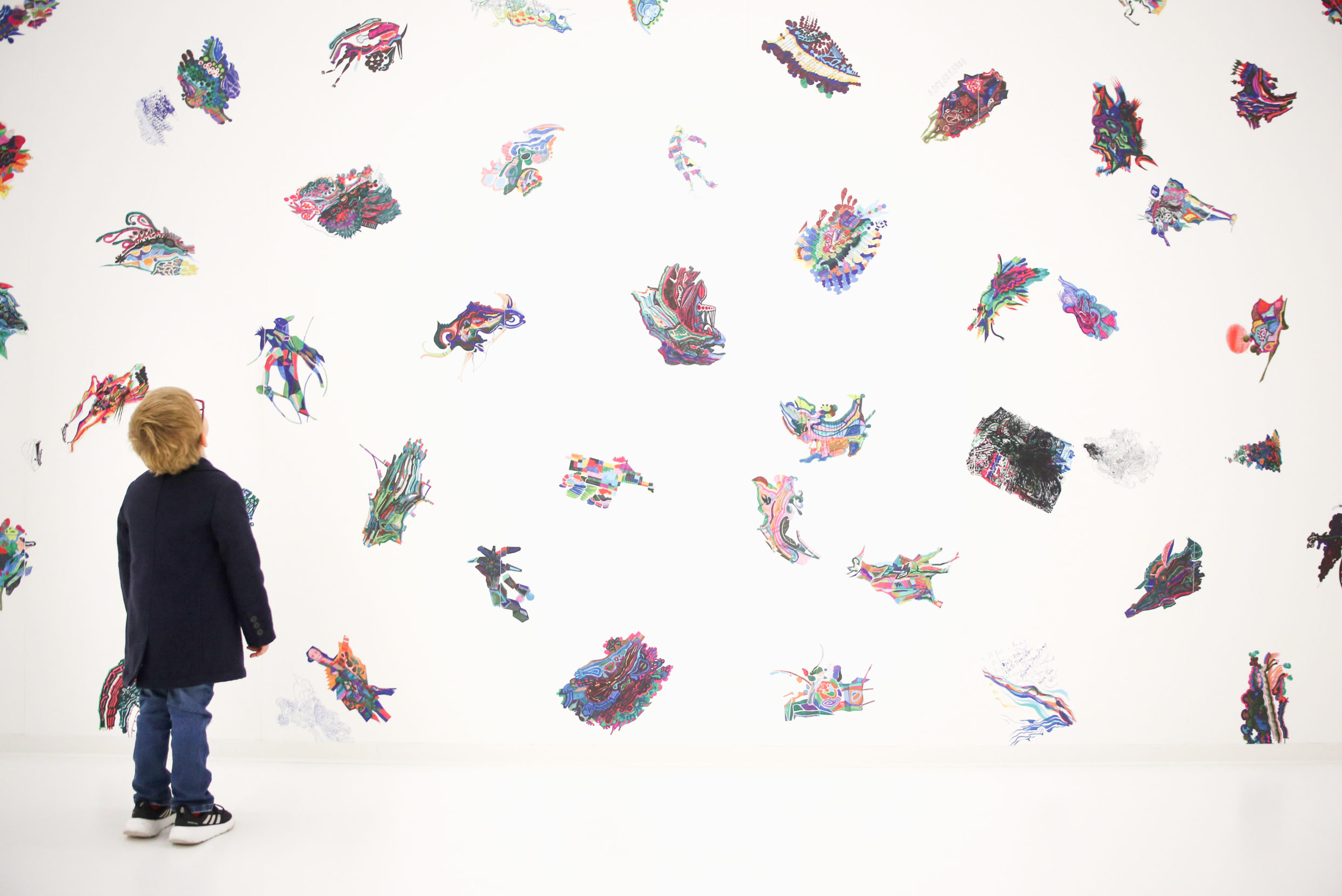
At a 2018 exhibition in Germany, a child takes in artwork by Albanian Prime Minister Edi Rama. The whimsical abstractions emulate the unconventional wallpaper that Rama designed for his government office in Tirana. Photo: Danny Gohlke/dpa/Alamy Live News.
As mayor, Rama knew that harnessing creativity could shift perceptions — and give more than those tired, old buildings a new lease on life. That’s why he had made the paint stunt his first order of business, even as city budgets hovered near zero and countless challenges vied for his attention.
“Art,” he says, “was part of the answer.” Air conditioning units were painted green, and balconies washed in red. Rainbow murals and dazzling geometric patterns came to adorn once drab facades.
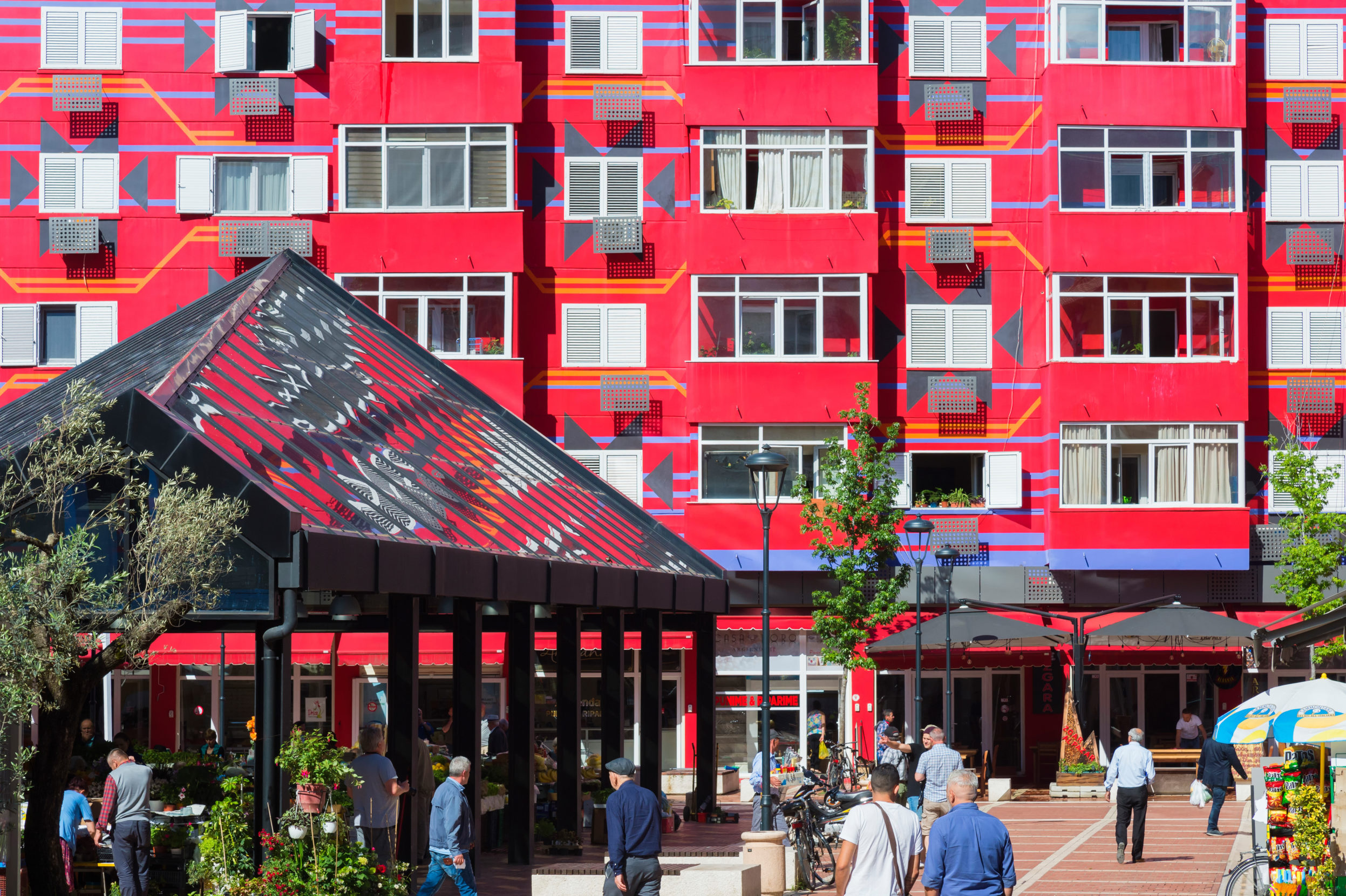
Brightly hued facades have become a hallmark of Tirana, Albania, ever since Edi Rama took the capital’s reins as mayor in 2000 and embarked on a painting campaign to rejuvenate Communist-era buildings with color. Photo: Gabrielle/Adobe.
“But this use of colors was not just an artistic act,” Rama bellowed from the stage, pumping a loose fist for emphasis, his cadence polished. “Rather, it was a form of political action.”
As the capital became a brighter, more aesthetically pleasing space, Albanians felt safer. Crime fell. Just over a decade later — a year after his TEDx talk, in which he aligned himself with Barack Obama and Franklin D. Roosevelt alike — Rama rode a wave of popularity into office as Albania’s prime minister.
As Etleva Lala explains it, the politician’s success lies in his embrace of artistic freedom, and the way he leverages that power to shape his country’s outlook. “This approach of Edi Rama to create the illusion of belonging in Europe, superficially in an artistic way,” she says, “makes a difference.”
Through his art and unconventional actions, Rama managed to awaken something that had long been dormant here — pride.
~~
On the benches that pepper the vast expanses of Skanderbeg Square, elderly men lean forward on their sticks, cigars in hand and trilbys and flat caps on their heads. They are men who have seen it all, their eyes tired from watching the rise and fall of fascism and communism, and the emergence of capitalist Albania. They smoke and play chess and put the world to rights.
Young men and women, born into a democratic and free Albania, rush about in tight jeans and kitten heels, designer T-shirts and tennis shoes, many of them too busy to look up from their phones.
“Art was part of the answer.” —Edi Rama
Cars honk; buses trundle by. Red Coca-Cola parasols shade al fresco cafes. The sunlight catches the domed roof of the nearby 18th-century Et’hem Bej Mosque, and lights up the monumental buildings, designed by Fascist architects in neo-Renaissance and Rationalist styles, where the government holds their offices.
Still a young nation, Albania’s story continues to evolve. Corruption, organized crime, and unemployment remain challenges. Its European Union membership hangs in the balance. Rama, who faces reelection this year, has not been without controversy. His legacy, beyond the colorful facade, remains to be seen.
~~
A handsome 71 years old, Robert Permeti has slick white-and-gray hair, and that wide jawline that gives his face an elegant air. Even today, he has a wild glint in his dark brown eyes, the kind that’s intriguing and infectious. It’s the sort of cheeky expression that invites you to follow him down the rabbit hole — the kind of expression the Communists probably hated.
Last summer, he set off on a journey from Tirana to southern Albania that saw him navigating hairpin turns over the steep mountain passes of the country’s interior. His heart in his throat, he drove through crumbling Ottoman towns where old stone castles tower over steep cobbled streets, and he didn’t stop to admire the verdant slopes of an undulating landscape. The day before, Permeti had received a call from an old associate who had spotted one of his paintings in a private home. Permeti was desperate to lay his eyes on the sturdy heroine he’d once portrayed on canvas in a painting called The Reward of the First Brigade.
In front of his canvas, Permeti found solace.
The artwork depicted a hard-faced woman in uniform, green military cap bearing the five-pointed Communist star, surrounded by officers, with snowy mountains in the distance. The piece was born out of Robert’s mind in the 1970s. He spent months researching every minute detail, from the faces to the uniforms and the shape of the mountain peaks. When it went missing from his studio in Librazhd in the ’90s, he was devastated.
Three decades later, he stood in the garage of a stranger, staring into a pair of unmistakable eyes he would never forget. The Reward of the First Brigade was an unofficial portrait of his late mother.
~~
In an understated two-story building on a quiet, residential street in the suburbs, Permeti strides up the concrete staircase to his second-floor studio, his footsteps echoing off the walls where his paintings hang.
Since the 1990s, Permeti has diligently tracked down his paintings from the Communist era, often buying them off the black market. At the turn of the new millennium, average monthly salaries in Albania were the equivalent of $40 to $50. Spending $300 on his own work was a sting, but a sacrifice worth every penny.
“Buying back my own art was the best thing I’ve ever done,” he says.
He gazes at the canvases crowding his studio like a mother admiring her children. They are his prized possessions, his life’s work. His chest visibly puffs out as he talks about each painting.
Most of it was painted during the Communist era, in the socialist-realist style that Enver Hoxha and the regime loved, but with the sort of twist only Permeti could have gotten away with. There’s a gaggle of female volleyball players in hot pants — “No one had ever painted women with such bare legs before,” he brags — and a brigade of Navy officers in smart white shirts, marching with the Albanian flag. The paintings are vast, five feet high or more, with the same intricate detail no matter the scale.
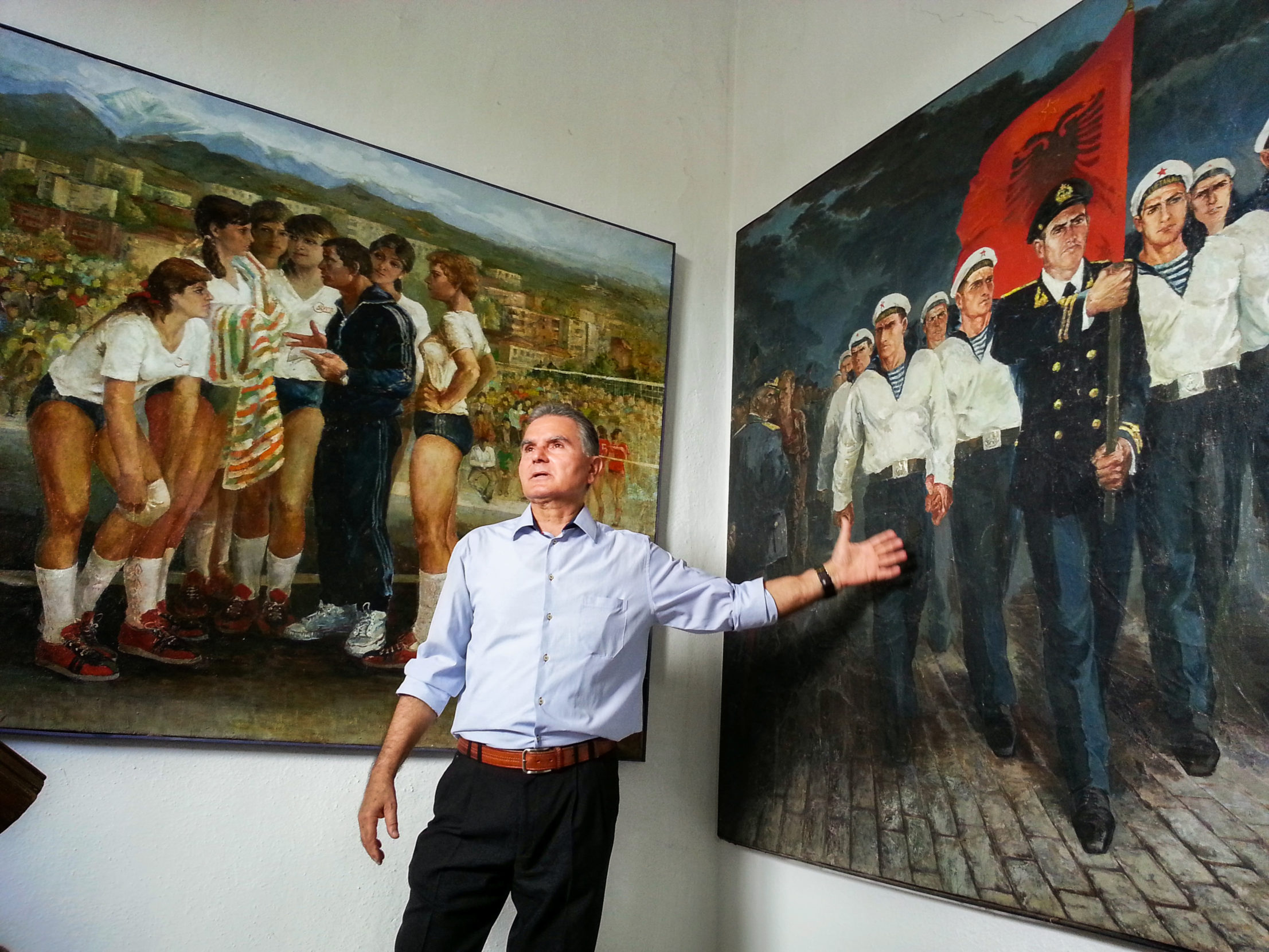
As a respected military officer during Europe’s last dictatorship, Albanian artist Robert Permeti pushed the limits of Communist censorship — including modesty standards and historic details inconvenient to the regime. Photo: Edward Reeves/Drive Albania.
On the upper level of the studio, his recent works sit on easels with paints scattered around. Dogs smoke cannabis; fat politicians stand with their hands in their pants or pass out condoms to beggars. Permeti looks back on the Communist days with horror, and is, finally, embracing his right to antagonize those in power.
“I’m free now,” he says. “I can use all the sarcasm I want, and I can openly paint political satire.”
His old paintings, some of which were once locked away out of sight, now travel the world as part of museum exhibitions. These showcases of socialist realism portray both the talent of the individuals as well as the context in which their art was created.
“Buying back my own art was the best thing I’ve ever done.” —Robert Permeti
In between shows, one scene takes pride of place at the top of the staircase, where all can appreciate its depth.
Rescued from oblivion and reclaimed by its creator, The Abyss looms large.
Lottie Gross
Lottie Gross is an award-winning travel writer and editor from south Oxfordshire, England, who has traveled the world updating guidebooks in India and reporting on community projects in Uganda.



